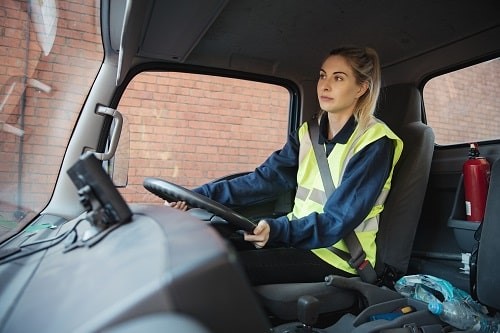Work-related road safety has been high on the agenda in recent years and, as greater numbers of people have returned to the roads following the end of Covid-19 lockdown restrictions in 2021, there has been a corresponding increase in road casualties.
Opinion
Managing work-related road risk with vehicle safety technology
The recently published Department for Transport (DfT) statistics on reported road casualties in Great Britain reveal a figure of 27,450 killed or seriously injured casualties in 2021, an increase of 14 per cent compared with 2020. While the 2021 figures are said to be lower than pre-pandemic levels, the DfT reports that during the latter half of 2021 road casualties and traffic returned to levels similar to those seen in 2019.
So, what about employees who drive for work? A study from December 2020 funded by National Highways (then known as Highways England) considered data from 2018 and found that nearly a third of all road fatalities involved someone driving for work. The study also concluded that more deaths occur from work-related road travel than in the workplace.
 Matthew Sulley: "Work-related road hazards are well known – including fatigue, distraction, time pressures, vehicle condition and the behaviour of other road users to name but a few."
Matthew Sulley: "Work-related road hazards are well known – including fatigue, distraction, time pressures, vehicle condition and the behaviour of other road users to name but a few."
Tragically, in 2018 of the 520 fatalities in Great Britain arising from collisions involving a person driving for work, the majority (83 per cent) were of other road users, the study found. The study, which looked specifically at the risks associated with driving cars and light vans for work purposes, also concluded that there is no accurate estimate of the number of cars in the grey fleet, which is defined as vehicles owned by employees but used for business purposes.
Work-related road hazards are well known – including fatigue, distraction, time pressures, vehicle condition and the behaviour of other road users to name but a few. Employers have duties under the Health and Safety at Work Act 1974 (HSWA), as well as the relevant requirements under the Management of Health and Safety at Work Regulations 1999, which involve assessing and eliminating or reducing risks to the health and safety of their employees while they are at work. This includes when employees are driving for work purposes. The duties apply whether the employee is using a company-owned vehicle or their own ‘grey fleet’ vehicle.
In ensuring that these duties under HSWA are discharged, to both their employees who drive for work purposes and other road users who could be affected by their employees’ work-related driving, employers must assess the risks from work-related driving and then implement reasonably practicable control measures to manage the risks to company drivers and other road users. The monitoring and review of those control measures is imperative to ensure they remain effective in reducing the risk of road incidents, such as collisions, that could put company drivers and others in danger.
When seeking to manage occupational road risk, previous Health and Safety Executive (HSE) guidance (known as INDG382), encouraged employers to focus on assessing and reducing risks in three main areas. These are the driver (including considering their competency, training, fitness and health); the vehicle (its suitability, condition and safety equipment) and the journey (namely the route, scheduling, time, distance and weather conditions). This is reflected in the HSE’s updated online guidance on driving and riding safely for work which also states that: “The main areas you should look at in your risk assessment are the journey, the driver or rider and the vehicle.”
Vehicle safety monitoring technology
HSE has also updated its online guidance on driving and riding safely for work to take account of the recommendations of a Transport Research Laboratory report prepared for HSE and DfT in 2020. This recommended that the previous INDG382 guidance should be updated to include references to vehicle safety monitoring technology, and identified these as including:
- Vehicle telematics – this includes devices that can record information on driver behaviours and in the event of a collision. It also includes devices that can provide information in real-time to drivers, such as warnings about their driving style or speed, and provide information to management about the driver’s behaviour, either in real-time while the person is driving or through post-event analysis of recorded data
- Intelligent speed assistance – including alerting the driver when the vehicle is travelling in excess of the speed limit and mandatory limiting of the vehicle’s speed
- Drowsiness and distraction recognition – this may include using vehicle monitoring measures (such as spotting if the vehicle drifts from one lane to another), behavioural measures (such as facial movements) and physiological measures (such as signals measured by electrocardiogram, or ECG) to identify when the driver may be falling asleep
- Automatic emergency braking systems and forward collision avoidance – these use sensors to track the position of vehicles ahead of the driver and either automatically apply the brakes to avoid a collision or warn the driver.
HSE’s updated online guidance says employers should consider whether such technologies could help them to “monitor indicators of risky driver behaviours like excessive speed, harsh or erratic driving, distraction and drowsy driving”.
However, the fact they are mentioned in the guidance means an employer should consider whether it is reasonably practicable to adopt these technologies when seeking to manage work-related road risk. This is because compliance with HSE guidance can help an employer to demonstrate that they have discharged their health and safety duties under the HSWA.
When purchasing company-owned vehicles, it will be possible to consider whether they should be fitted – or retro-fitted – with suitable vehicle safety technologies. However, where employees use grey fleet vehicles the application and implementation of vehicle safety technologies to help manage work-related road risk may pose difficulties. However, these are perhaps not unsurmountable – for example, if employees agree to have telematics systems added to their private vehicles used for work.
More generally, to ensure the safety of grey fleets, it is critically important that employers ensure their driving for work, fatigue management and lone working policies are comprehensive, robust and fully implemented. The competence and training of drivers should also be regularly checked and assessed to ensure employees continue to have the necessary level of driving ability and awareness to stay safe on the road.
 Photograph: iStock
Photograph: iStock
Employers should also regularly assess and check that drivers of grey fleet vehicles understand how to maintain their vehicle in a safe condition. Employees must also fully understand that they have legal obligations as a vehicle owner and road user. This includes a duty to take reasonable care for their own health and safety and that of other people who may be affected by their actions at work, including while driving, and ensuring their vehicle is safe to use on the road.
Financial and reputational consequences
The consequences for employers of failing to adequately manage work-related road risk are well known. For example, in May 2020 Renown Consultants Limited was fined £450,000 for health and safety offences following the death of two of its workers in a road traffic collision. The two men were travelling in a works van following a night shift in the early hours of the morning when the driver fell asleep, causing the vehicle to crash into a parked van. The company was found to have failed to carry out a sufficient assessment of the work-related road risks and had failed to comply with its own fatigue management procedures.
If an employer decides to deploy vehicle safety technologies to reduce the risks from driving and riding for work, it is critical that they effectively consult and engage with their employees to ensure their successful implementation, adoption and use. This is particularly important when it comes to grey fleet vehicles, where employees may be reluctant to have safety technology fitted to their vehicle.
Employers will need to develop suitable policies and procedures specifying when, how and why new vehicle safety technology will be used, and drivers will require clear training, instructions and guidance on its correct use and the reasons for its adoption.
Once vehicle safety technologies have been adopted, their performance – and any data they provide, such as on poor driver behaviour – must be regularly monitored and measured. This will help the employer assess their effectiveness in reducing work-related road risk – for example, by spotting risky behaviours that can be corrected through driver training and education.
Finally, it is generally a good idea to trial the use of new vehicle safety technologies before rolling them out across a business, as this often provides the opportunity to identify and resolve any issues prior to their wider introduction.
Contact Pinsent Masons at: pinsentmasons.com
Matthew Sulley is associate at Pinsent Masons LLP
OPINION

How to create a neuroinclusive workplace
By John Robinson, Schofield Sweeney on 09 December 2025
The modern workplace is a diverse environment. Most workforces will be made up of individuals representing the majority of the groups protected under the Equality Act 2010.

Don’t lose autism in the neurodiversity wave – why targeted reform is essential
By Rt Hon Sir Robert Buckland KBE KC on 03 December 2025
Autistic adults have waited too long for meaningful reform. They have shared their experiences and expertise. Now they deserve action, accountability, and transformation.

Inclusion saves lives: embedding equality, diversity and inclusion (EDI) into global occupational safety and health
By Umer Changaiz, CMIOSH on 03 December 2025



